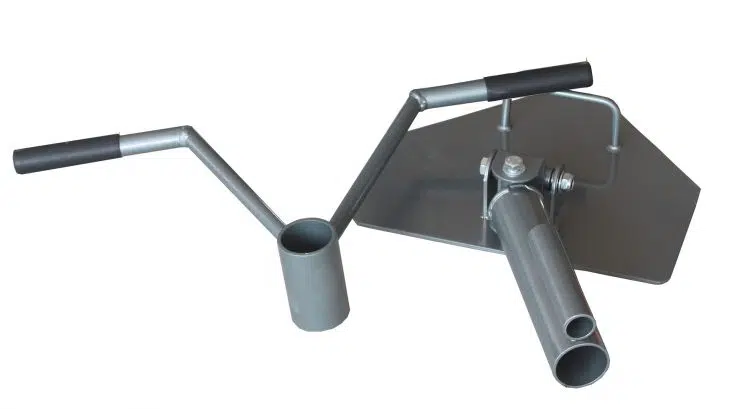The landmine is one of the most versatile training devices in the gym. Using just a landmine and a barbell, you can train virtually every muscle in your body, including your upper body, lower body, and core. Most landmine exercises are very joint-friendly, too.
One of the best landmine exercises is the overhead press. Done correctly, this exercise is like a standing incline press, so it hits your deltoids, chest, and triceps at the same time. It can be done bilaterally, meaning with two arms, or unilaterally using one arm at a time. The unilateral version is also a great core stability exercise.
Needless to say, if you want to do landmine presses, you’ll need a landmine device. This is basically a multidirectional hinge. With one end of your barbell in the landmine, you then grip and lift the opposite end.

No landmine? No problem! You can simply wedge your barbell into a corner for a very similar training effect.
But, while there is no denying the effectiveness of the landmine press, like any exercise, it will start to become less beneficial if you do it over and over again. Your body is a master of adaptation and will soon get used to the demands of doing landmine presses.
Because of this, to avoid training progress plateaus, you MUST include plenty of variety in your workouts. That doesn’t mean switching exercises every time you train. Still, you should reorganize your workouts every 4-6 weeks to avoid training ruts.
Level Up Your Fitness: Join our 💪 strong community in Fitness Volt Newsletter. Get daily inspiration, expert-backed workouts, nutrition tips, the latest in strength sports, and the support you need to reach your goals. Subscribe for free!
You don’t have to give up landmine presses for good, but a few weeks’ break will mean that, when you return to it, the landmine press will be productive again.
In this article, we reveal the 13 best landmine press alternatives.
Landmine Press Anatomy
For any exercise to be considered a viable alternative for the landmine press, it needs to use the same muscle group(s). The landmine press works the following:
Deltoids: The deltoids are your primary shoulder muscles. There are three sets of fibers, called heads, which work together but also have individual functions. The three deltoid heads are:
- Anterior – located at the front of your shoulders, the anterior deltoid is the most active head during landmine presses.
- Medial – located on the side of your shoulder, the medial deltoid gives your shoulders their width.
- Posterior – this is your rear deltoid. Used mainly as a stabilizer during landmine presses, the posterior deltoid is an important postural muscle.
Pectoralis major: Better known as your pecs, the pectoralis major is your main chest muscle. Landmine presses tend to emphasize your upper chest, which is known as the clavicular head.
Triceps: Located on the back of your upper arm, your triceps are responsible for extending your elbows during landmine presses.
Core: The collective term for the muscles of your midsection, including rectus abdominis, obliques, transverse abdominis, and erector spinae. These muscles work together to stabilize your spine when you do landmine presses. The unilateral version is more core-centric than the two-armed version.
Top 13 Landmine Press Alternatives
No landmine device available? Or do you just need a different exercise to liven up your workouts? Maybe you don’t even like landmine presses? Either way, we’ve you covered! Here are the 13 best landmine press alternatives.
1. Steep incline dumbbell press
Most lifters use a 30 to 45-degree bench angle to do incline presses. While this will increase upper chest engagement, you need to go steeper if you want to replicate landmine presses. Raise your bench to around 60-70 degrees to mirror the demands of landmine presses. Dumbbells will allow you a greater range of motion, and you can use just one weight to increase core activation. Alternatively, try this exercise with a barbell.
Learn how to do this exercise here, remembering to set your bench to 60 to 70 degrees.
2. Dumbbell overhead seesaw press
The dumbbell seesaw press is a useful landmine press alternative that works your shoulders, triceps, and core. It can be done seated or standing, although the standing variation involves more core engagement. You can do this exercise with dumbbells or kettlebells as preferred.
How to do it:
- Raise and hold your dumbbells/kettlebells to your shoulders, palms facing forward. Engage your core, pull your shoulders down and back, and press one weight overhead. This is your starting position.
- Lower that weight to your shoulder and simultaneously press the other weight up. Your arms should move at the same speed.
- Continue this seesaw movement for the required number of reps.
- You can also do this exercising using a neutral or palms-in grip.
3. Z-press
The Z press is a barbell overhead pressing exercise named after legendary Lithuanian strongman Žydrūnas Savickas, better known as Big Z. Like landmine presses, the Z press works your delts, triceps, core, and upper chest. This exercise is challenging, but after a few weeks of doing the Z press, the landmine press should start to feel a whole lot easier!
How to do it:
- Between the uprights of a squat rack, sit on the floor with your legs straight and spread wide for balance. Place a barbell on the J-hooks at about shoulder height. Sit up tall, brace your abs, and hold the bar with an overhand, slightly wider than shoulder-width grip.
- With your core tight and shoulders down and back, unrack the bar and hold it across your shoulders as you would for regular overhead presses. Do not lean forward or back. Lift your chest.
- Keeping your core tight, press the bar up and overhead.
- Lower the bar back to your shoulders and repeat.
- Focus on maintaining a good upright posture and tight core throughout. Do not allow your lower back to round, so no slouching!
Read more about the Z press in our in-depth guide.
4. Military press
The military press is a strict standing overhead barbell press. Because it’s done standing, your core gets a workout along with your deltoids and triceps. Ideally, the military press should be done with straight legs and no assistance from your lower body. This ensures your upper body does all the work.
Traditionally, this exercise is done with the legs together and heels touching – like you are standing to attention. However, a wider stance will be more stable and means you can lift heavier weights. You can do military presses using a barbell, dumbbells, or kettlebells.
Learn how to do military presses here.
Level Up Your Fitness: Join our 💪 strong community in Fitness Volt Newsletter. Get daily inspiration, expert-backed workouts, nutrition tips, the latest in strength sports, and the support you need to reach your goals. Subscribe for free!
5. Single-arm dumbbell press
Pressing any weight overhead will develop your deltoids and triceps. However, when you use just one arm, your core gets a better workout. The standing single-arm dumbbell press is a low-tech alternative to landmine presses.
How to do it:
- With your feet shoulder-width apart for stability, brace your core and raise a dumbbell to shoulder height. Turn your wrist so your palm is facing forward or, if you prefer, use a neutral grip with your palm turned inward.
- Without using your legs, press the weight up and overhead to arms’ length.
- Lower the weight back to your shoulder and repeat.
- You can also do this exercise with a single kettlebell.
6. Push press
The push press is an explosive overhead press where you use your legs to help you drive the weight up. This increases the amount of weight you can lift and also develops muscle power, which is force generated quickly. Power is a vital component of most sports. You can do push presses with a barbell, dumbbells, or kettlebells.
How to do it:
- Hold your weight(s) at shoulder level. Stand with your feet about hip-width apart, and your core braced. Pull your shoulders down and back.
- Descend into quarter-depth squat and then stand up explosively.
- Use this momentum to help you drive the weight up and overhead to arms’ length.
- Lower the weight back to your shoulders and repeat.
7. Pike push-ups
No weights? That’s okay; you can still develop strong, muscular shoulders using nothing but your body weight for resistance. The pike push-up places your body in an inverted position, turning what is usually a horizontal pushing exercise into a vertical one.
How to do it:
- Adopt the push-up position with your arms and body straight, hands about shoulder-width apart. Brace your core.
- Lift your hips and walk your hands back toward your feet, so your body forms an inverted V-shape.
- Bend your arms and lower your head to the floor.
- Push yourself back and up, and then repeat.
- Increase your range of motion by using push-up handles. Make this exercise harder by putting your feet on a step or bench and putting more weight on your hands.
8. Wall ball
Wall ball is a classic CrossFit exercise. While this move is very much a full-body exercise, it’s especially tough on your shoulders and triceps. Done for high reps, wall ball is great for building muscular endurance and cardiovascular fitness. All you need is a medicine ball and a wall.
How to do it:
- Hold your medicine ball in front of your chest with your hands toward the bottom of the ball. Standing a couple of feet back from a tall wall, adopt a shoulder-width stance. Brace your core.
- Bend your legs and squat down until your thighs are roughly parallel to the floor. Do not round your lower back.
- Stand up quickly and push-press the ball up to hit the wall above your head. In CrossFit, the target is usually ten feet above the floor.
- Catch the ball as it descends and then repeat.
9. Thrusters
The thruster is another CrossFit staple. Like wall ball, it combines a lower body exercise (front squats) with overhead presses. As such, thrusters are a functional exercise and an acceptable alternative to land mine presses.
How to do it:
- Stand with your feet shoulder-width apart, toes turned slightly outward. Rack and hold a barbell across the front of your shoulders, with your upper arms roughly parallel to the floor. Your hands should be just outside shoulder-width apart. Brace your core.
- Push your hips backward and squat down until your thighs are roughly parallel to the floor. Do not round your lower back, but feel free to descend deeper if your flexibility and knee health allow. Your torso should remain relatively upright.
- Stand up quickly, using this momentum to help you push the barbell up and overhead to arms’ length.
- Lower the bar back down to the front rack position, descend into another squat and repeat.
- You can also do thrusters with dumbbells.
Read more about thrusters here.
10. Single-arm twisting cable overhead press
The twisting cable overhead press comes very close to mimicking the exact demands of the landmine press. Adding a twist will really fire up your core, especially your obliques. No cable machine? You can also do this exercise using a resistance band.
Learn how to do single-arm twisting cable overhead presses here.
11. Straight arm sled push
Most people use weighted sleds for fat burning and conditioning, but they’re also a helpful strength training tool. While this exercise most definitely involves your lower body, keeping your arms straight means it also provides your shoulders, triceps, core, and upper chest with a beneficial strengthening workout.
How to do it:
- Load up your sled and then get behind it and grip the vertical handles. Lean forward so your upper body is close to parallel to the ground. Brace your core.
- With your upper body engaged, push the sled forward using your legs. Do not allow your lumbar spine to round or your arms to bend.
- Continue for the prescribed duration or distance.
12. Sled press with straps
Working your pecs, anterior deltoids, triceps, and core, this exercise is an excellent alternative to landmine presses. With no eccentric contraction, sled presses with straps are also very joint-friendly. Pair with sled rows to work your upper back and your entire upper body in double-quick time.
How to do it:
- Attach two straps to your sled and a D-shaped handle to each end. Stand with your back to your sled and a handle in each hand. The straps should run under your arms. Bring your arms up so your hands are about level with your shoulders and close to your armpits.
- Walk forward to tension the straps.
- In a staggered or shoulder-width stance, brace your core and extend your arms to push the sled forward.
- Walk forward and bend your arms to return to your starting position. Reset your core and repeat.
13. Waiter’s walk
Waiter’s walks are a load-carrying exercise that works your core, triceps, and deltoids. Weighted carries are a functional way to build full-body endurance and strength. They’re also a useful metabolic conditioning (met-con) training method. You can do waiter’s walks using two dumbbells or if you want to work your core harder while carrying just one weight.
How to do it:
- Brace your core and lift and holds your weight(s) above your head. Pull your shoulders down and back.
- Keeping your shoulders and hips level and your arm(s) straight, take a walk around your training area.
- Continue for the prescribed distance or duration.
- Make this exercise harder by walking zigzags or around and over obstacles. You’ll have to work harder to keep the load stable.
More Alternative Exercises:
- Best Box Jump Alternatives
- Best Alternatives to Lunges for Bad Knees
- Crunches and Sit-Up Alternative
- Triceps Pushdown Alternatives
- Seated Cable Row Alternative
- Romanian Deadlift Alternatives
- Cable Crossover Alternatives
- Hip Thrust Alternatives
- Back Extension Alternatives
- Leg Extension Alternatives
- Leg Curl Alternatives
- Bench Press Alternatives
Landmine Press Alternatives – Wrapping Up
We don’t know who invented the landmine training device, but whoever it was, they were one smart cookie! The landmine is incredibly versatile and provides a safe way to develop functional strength and muscle mass.
But just because WE love the landmine doesn’t mean that everyone does or that you’ll have access to one. Don’t worry; as effective as landmine training is, it’s not compulsory. There are plenty of equally good workout methods and exercise you can use to reach your training goals.
So, no landmine press? Just do one of these 13 substitutes instead!
Interested in measuring your progress? Check out our strength standards for Bench Press, Push Ups, Dumbbell Bench Press, and more.








